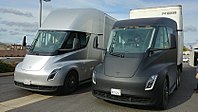
Photo from wikipedia
Global deterioration of marine ecosystems, together with increasing pressure to use them, has created a demand for new, more efficient and cost-efficient monitoring tools that enable assessing changes in the… Click to show full abstract
Global deterioration of marine ecosystems, together with increasing pressure to use them, has created a demand for new, more efficient and cost-efficient monitoring tools that enable assessing changes in the status of marine ecosystems. However, demonstrating the cost-efficiency of a monitoring method is not straightforward as there are no generally applicable guidelines. Our study provides a systematic literature mapping of methods and criteria that have been proposed or used since the year 2000 to evaluate the cost-efficiency of marine monitoring methods. We aimed to investigate these methods but discovered that examples of actual cost-efficiency assessments in literature were rare, contradicting the prevalent use of the term “cost-efficiency.” We identified five different ways to compare the cost-efficiency of a marine monitoring method: (1) the cost–benefit ratio, (2) comparative studies based on an experiment, (3) comparative studies based on a literature review, (4) comparisons with other methods based on literature, and (5) subjective comparisons with other methods based on experience or intuition. Because of the observed high frequency of insufficient cost–benefit assessments, we strongly advise that more attention is paid to the coverage of both cost and efficiency parameters when evaluating the actual cost-efficiency of novel methods. Our results emphasize the need to improve the reliability and comparability of cost-efficiency assessments. We provide guidelines for future initiatives to develop a cost-efficiency assessment framework and suggestions for more unified cost-efficiency criteria.
Journal Title: Environmental Monitoring and Assessment
Year Published: 2021
Link to full text (if available)
Share on Social Media: Sign Up to like & get
recommendations!